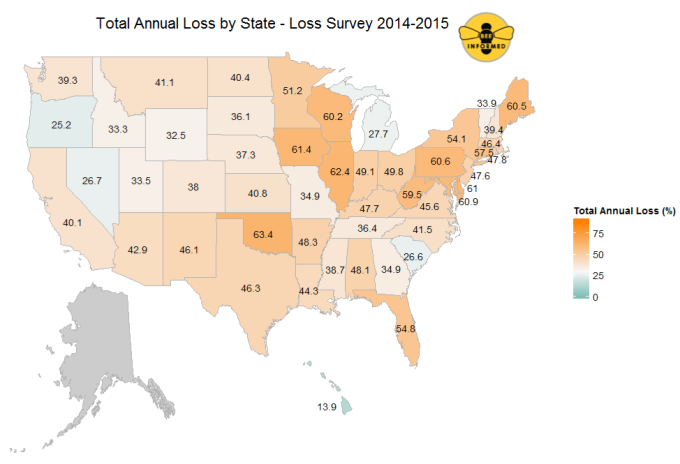- Update: We have added links to an article about the Monarch life-cycle and a 3D Monarch movie
- Update: We have added links to a Diane Rehm story that aired June 3, 2015
- Update: We have added links to a PRI story that aired May 21.
"A new federal plan aims to reverse America's declining honeybee and monarch butterfly populations by making millions of acres of federal land more bee-friendly, spending millions of dollars more on research and considering the use of fewer pesticides.
While putting different type of landscapes along highways, federal housing projects and elsewhere may not sound like much in terms of action, several bee scientists told The Associated Press that this a huge move. They say it may help pollinators that are starving because so much of the American landscape has been converted to lawns that don't provide foraging areas for bees."

"Pollinators are struggling," White House Science Advisor John Holdren said in a White House blog post. "A new federal survey found that beekeepers lost more than 42 percent of their colonies last year. More of the insects died in summer than winter for the first time since the US Department of Agriculture launched its annual honeybee survey. The number of monarch butterflies that spend the winter in Mexico's forests is down by 90 percent or more over the past two decades. The goals of the new strategy are to reduce overwinter honeybee death to 15% and to increase the Monarch population to 225 million."

"The stated goal of the bee and butterfly conservation plan is to restore and protect nearly seven million acres of habitat for these pollinating insects using a north-to-south corridor across the country. That will replace the land that's been lost to butterflies and pollinators due to pesticide use. Patches of high-quality habitat that's rich in flowers and free of pesticides forming a corridor from Mexico to Canada will help monarchs to find nectaring and breeding areas as they travel," says Scott Hoffman Black, the executive director at the Xerces Society for Invertebrate Conservation."
The Diane Rehm Show, June 3, 2015
Environmental Outlook: New Efforts to Support the Ailing Bee Population
Most scientists agree the problem is a combination of pests, disease, poor nutrition and toxins from pesticides, yet how big a role each of those plays is up for debate – as are the solutions. Now, President Barack Obama has weighed in with a plan to save the bees and other pollinators. But some say it doesn’t go far enough. We learn more about new efforts to support the ailing bee population.
You can help. Milkweed plants like these are where Monarchs spend summer, turning from caterpillars into butterflies.

To suburbanites, they're weeds. To the Monarch butterfly, they are hearth, home, and nursery. Mow around them. Plant a $3 butterfly garden. But be careful. Potted milkweed plants (Asclepias) from Nurseries and Home Centers have probably been treated with systemic insecticides. Treated plants can kill Monarch caterpillars in three bites.
Below are photos of my neighbor's honeybees visiting spring tree blossoms on my place. The blossoms are pretty, but they don't last long. Because I don't use herbicides that kill everything but lawn grass, during the rest of the year my neighbor's bees can feed on clover in my lawn. Clover flowers continuously through the summer. The local bees can also feast on spring Dandelions. I don't kill those either.
Bordering my minimal mowed area is a field filled with wildflowers like the Goldenrod above, its kindred Asteraceae, and of course, Milkweed. Pollinators need all these to feed on while your fruit trees grow fruit and your garden makes vegetables.
What else do these "weeds" do? They provide oxygen for people who live surrounded by asphalt.
The Life cycle of the Monarch. The migration north takes 3 generations, following the Milkweed bloom. A final fall generation migrates south, overwinters, mates, and lays the eggs of the generation which will begin the return journey north.
Flight of the Butterflies - a 3D movie
After years of research, in 1975 Dr. Fred Urquhart discovered the southern terminus of Monarch migration. This movie tells the story. It turns on the discovery of PS 397, the monarch butterfly tag that was released by two school boys and their teacher from Chaska Minnesota in early August 1975. This same tag and butterfly ended up being the very one Dr. Fred Urquhart found four months later, on January 9th, 1976, 10,000 feet high in the remote Sierra Madre mountains of Michoacan Mexico. The butterfly would have flown over 2,000 miles and for at least two months to get there.

Honeybee hovering over a Wild Apple blossom

Honeybee feeding on a Redbud blossom

A Cranberry-hued Crabapple blossom with honeybee

